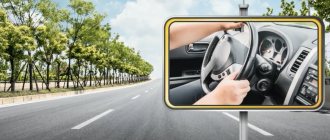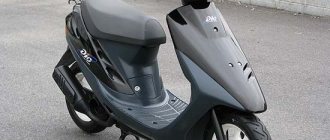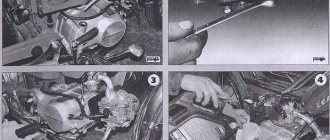ATVs are now widely used on farms, in tourist parks, and in holiday homes as a universal means of transportation on dirt roads, fields and even forest clearings. These all-terrain vehicles are also gaining popularity among hunters and fishermen due to their ease of use and high cross-country ability. They are much more convenient than conventional SUVs, because they can take one or two passengers to places where other vehicles would simply get stuck. Meanwhile, when operating ATVs on asphalt roads and when they appear in cities and towns, drivers may have difficulties with the traffic police. What's the matter?
What kind of non-standard license plates will now be issued in Russia? More details
What is an ATV?
The ATV combines the best characteristics of a motorcycle, jeep and tractor. In Russia, this concept includes all-terrain vehicles. ATVs have been around for a long time, but have gained popularity over the past seven years. The best route for these vehicles is off-road, where a passenger car or even a motorcycle cannot pass. But is it possible to ride an ATV around the city?
Sanctions for violations
In terms of violations of traffic rules, a driver is no different from someone who drives a regular car. For non-compliance with the rules, there are certain fines, and in some cases you can lose your license. ATV drivers are often fined for the following violations:
- Driving on a highway with appropriate prohibitory signs. Fine 5000 rub.
- Traveling without a helmet. Fine 1000 rubles. Sanctions apply to the driver, but also to the passenger.
- Violation of the rules for transporting minors. For this, a fine of 3,000 rubles is provided.
- Moving without documents - registration certificate, license or insurance. For lack of a license, you can receive a fine from 5,000 to 15,000 rubles. If there are no other documents, you will have to pay a fine of 500 rubles.
To avoid financial fines and not face such an unpleasant phenomenon as the deprivation of a driver’s license, you should follow the established safety rules and do not forget your documents. To avoid moving in prohibited areas, you should carefully study the area. There should be no prohibiting signs or corresponding markings on the road.
Traffic rules and traffic police requirements
All provisions regarding ATVs have not yet been enshrined in legislation. Therefore, when driving self-propelled vehicles on city roads, controversial issues often arise. But since ATVs do not interfere with other road users, there are no prohibitions on these vehicles. But there are general traffic rules that must be strictly observed:
- ATVs must be equipped with full headlights, rear-view mirrors and turn signals;
- the total weight of the vehicle cannot exceed 400 kilograms;
- The maximum speed of the ATV should be no more than 40 km per hour.
These requirements are designated for road safety, so that in the general traffic flow there are no problems for other road users. Why can’t ATVs be driven around the city if the above requirements are not met? This is fraught with dangerous situations on the road both for the driver of the ATV and for other road users.
Recently, traffic rules have changed frequently. Therefore, it is worth paying attention, if necessary, to equipping a self-propelled vehicle with additional lighting devices. In addition, this vehicle must have license plates registered with the traffic police.
Special characters
There are no special signs allowing you to ride an ATV. The rules for these machines are regulated by prohibitory signs. Among them are:
- Sign 3.4. Truck traffic is prohibited.
- Sign 3.5 Tractor traffic is prohibited.
- Sign 5.3 Road for cars.
- Sign 5.1 Motorway.
Along with these signs, it is worth following the installed signs and numerous markings.
If there are appropriate signs, you should stop driving the ATV.
You can't break the rules. The person driving the vehicle bears full responsibility for violating traffic rules. This condition applies to all road users without exception.
Paperwork
Documents are issued, in accordance with the law, for any vehicle. ATVs are no exception to the rule. The driver must have with him:
- valid driver's license;
- documents on the passed technical inspection;
- insurance policy for the vehicle.
Is it possible to ride an ATV on public roads? Yes, but only if the driver has been trained in a special driving school. After this, a driver's license is issued with a note indicating permission to drive a specific vehicle.
ATV registration and license
In solving most issues in this category, one should rely on the rules that apply only to tractors. The reason is that ATVs fall into this category.
To operate an ATV, you must have a driver's license.
Rights with open category B cannot be used. You must have a tractor driver's license, that is, category A. You are allowed to obtain this document at the age of 16. With such a certificate, you can drive any motor vehicle - motorcycle, ATV, snowmobile.
After purchasing the described vehicle, it must be registered. This requirement applies to all vehicles with an engine capacity of 50 cm3 or more. To register, you need to have the following documents:
- PTS;
- Contract of sale;
- A copy of the official certificate of technical and structural conformity;
- Special documents if the equipment was assembled in another country.
After registering the car, you must issue a special passport for the mini-tractor. This is done in the Gostekhnadzor organization. A standard technical inspection is carried out. It turns out an insurance policy.
Obtaining a driver's license
To drive an ATV you must have a license with category “A”. If it is not there, then you should take special courses. The standard training period is one year. The courses are conducted in three stages:
- safety precautions when operating self-propelled vehicles;
- traffic rules theory;
- vehicle management practice.
If you already have a driver’s license, but do not have category “A”, then the learning process can be significantly reduced in time. Most often, repeating the traffic rules theory is not required.
Transportation of children
Almost all ATVs have special seats for passengers. This vehicle can be used to transport other people. But this should be done in accordance with certain rules:
- The driver and passenger must have a helmet. In case of an emergency, it will protect your head.
- You can carry passengers in the rear seat only if the appropriate conditions and design features are available. If the seat simply accommodates two people and there are no other handrails or belts, you cannot carry passengers.
- If there are special seat belts, passengers must be fastened.
- People can only be unloaded and loaded when the vehicle is completely stopped.
- It is prohibited to plant directly on the roadway. You should stop on the side of the road and make sure that there is no prohibiting sign.
- Passengers themselves must behave as calmly as possible. It is strictly prohibited to interfere with the driver’s actions or to stand up to his full height.
- It is prohibited to transport children under 12 years of age. You cannot ride holding them in your arms or carrying them on your knees.
- It is strictly forbidden to trust children to operate the ATV.
Since 2021, a rule has been in force that prohibits ATV drivers from transporting people and children if they have less than two years of driving experience by any means of transportation.
Registration of an ATV at the traffic police
Is it possible to ride an ATV around the city without registering the vehicle with the traffic police? No, since any vehicle is allowed to travel only after technical inspection. To do this, the ATV is first registered with Gostekhnadzor. Then a passport for the self-propelled vehicle is issued and it undergoes technical inspection. Then you get an insurance policy for the vehicle.
Since ATVs belong to the category of tractors, you need to focus on these vehicles in all matters. It is necessary to review amendments to legislation, which changes frequently.
Is it possible to ride without a license on a country road, in a forest or field?
Away from busy roads, there are many country roads through forests and fields. More than half of them are unpaved. However, standard traffic rules also apply here.
At the same time, traffic regulations explain that the road may not necessarily be equipped or even suitable for movement. This definition includes ordinary field routes with compacted soil.
Thus, for trips through forests and fields it is also better to have a license, license plates and a PSM registration certificate.
Features of traveling on an ATV
Riding an ATV in the city has its own characteristics, since this vehicle is intended more for movement on the ground and off-road. Self-propelled vehicles have design features that do not allow driving for long periods of time on asphalt or other hard surfaces.
In this case, ATVs will have to be repaired more often. Such vehicles have their own operating requirements. When driving within the city, you need to take into account the ambiguous attitude of other drivers towards self-propelled vehicles on the roads.
Is it possible to ride an ATV in the city? Yes, but not recommended. ATVs are made to travel on off-road and dirt roads, where driving is much slower than on a city highway. Therefore, at high speed and prolonged use of the vehicle on asphalt, the vehicle can be seriously damaged.
It should also be taken into account that many drivers do not consider it necessary to give way to motorcyclists, tractors and similar vehicles. And some motorists do not follow traffic rules at all. ATVs are not protected from the wind, so traveling in such vehicles in winter is inconvenient. But many of the listed shortcomings can be corrected in any car service center, of which there are quite a lot now.
Is it possible to ride an ATV in the city without a helmet? This question interests many fans of self-propelled vehicles. It is not necessary to wear a helmet when riding an ATV, but it is recommended. These self-propelled vehicles are not so often found on city roads, so traffic inspectors can find fault with such a driver. And for your own safety, a protective helmet won’t hurt. Perhaps soon it will even be included in the legislation as a mandatory attribute when driving self-propelled vehicles.
Permissible speed limit
The speed of movement on this vehicle is regulated by the usual established rules characteristic of all categories of vehicles. That is, in the city you need to move at a speed of 40 to 60 km/h. You should rely on the established limit signs.
For your own safety, you should not speed above 40 km/h.
This requirement is quite easy to comply with. The reason is that the design features of this vehicle do not allow it to develop high speed.
What should a driver have with him while driving?
Each ATV driver is required to carry the necessary documents and safety equipment. It is equally important to check the vehicle before starting your trip.
First of all, make sure that the tires are well inflated and there are no damages. Then the internal components, fuel, oil and brake fluid are checked.
These precautions help prevent serious damage to your ATV and a collision with another vehicle.
From documents
After checking the condition of the ATV, make sure that you have all the necessary documents with you.
These include:
- driver's license;
- technical inspection;
- passport of a self-propelled vehicle (analogous to a PTS);
- OSAGO policy.
Motor vehicle liability insurance is carried out in accordance with the established procedure. Each insurance company issues policies for motorcycles. Such a document is cheaper than for a car.
Many people are interested in whether it is possible to do without insurance? No, for the absence of a compulsory motor liability insurance policy, penalties are provided, as for drivers of passenger cars. Therefore, you should take care to purchase a policy after purchasing an ATV.
You cannot set off on an ATV without these documents. Some drivers believe that they can drive off-road without fear - traffic police inspectors do not “storm” forests and fields. But this opinion is wrong.
When moving from one point to another, there is a possibility of meeting an inspector on a road that the driver will simply cross. And then you will have to pay a rather large fine for the absence of the listed documents.
For safety
The technique of safe driving on an ATV requires the driver to always have with him:
- helmet on the head;
- reflective vest;
- kit for carrying out repair work in case of breakdown.
The helmet is put on before moving. This is not just a precaution, but a necessary manipulation that will save the driver’s life in an emergency.
Drivers of all types of vehicles must have a reflective vest. It must be worn in case of a forced stop on a dark highway due to a vehicle breakdown.
Going out onto the roadway without a vest is life-threatening, since drivers of cars moving on the same road simply will not see the pedestrian.
It is important to keep a repair kit with you if you have knowledge and experience in troubleshooting ATV problems.
The tools will help out in the field, forest, and off-road, where there is no mobile phone coverage and cars are rare. Even new equipment tends to break down, so you shouldn’t fully trust a recently purchased ATV.
When traveling in winter, you need to have warm clothes and a thermos with a hot drink. It is important to anticipate all situations that may happen during the trip.
Requirements for ATV drivers
Clause 11 of the RF PP No. 796 dated June 12, 1999 sets out the basic requirements for applicants for a driver’s license.
Only persons are allowed to take the exams:
- over 16 years of age;
- have successfully passed a medical examination;
- who have completed professional training in all-terrain vehicle driving courses.
If any of these conditions are not met, the applicant will not be allowed to take the exams.
List of documents
To obtain a driver's license, the applicant must prepare the following list of documents:
- Application on your own behalf for the issuance of a driver's license.
- Passport.
- Certificate of completion of a medical examination (confirming admission to exams).
- Driver's license of other categories (if available).
- Receipt for payment of state duty.
- Two photographs on 3x4 matte paper.
An applicant may be denied a medical certificate if he is diagnosed with the following diseases:
- endocrine disorders;
- epilepsy;
- motor dysfunctions;
- hepatitis;
- mental disorders;
- hearing and vision impairment;
- alcohol and drug addiction.
When paying the state fee, you must decide in advance on the type of license form. A driver's license issued on paper will cost 500 rubles, and on a plastic form – 2,000 rubles.
Why is an ATV better than a motorcycle or a car?
This question cannot be answered unequivocally. Much depends on your preferences.
In comparison, the ATV has the following advantages:
Higher cross-country ability and more comfortable driving.
Yes, the motorcycle handles better in some places, but the fact is that the “quad” will in most cases benefit from its stability and cross-country ability in off-road conditions, rain and snow. But it loses in dense forest conditions, where it is not always possible to squeeze through. In addition, there is no need to “maintain” balance, which in turn reduces fatigue during a multi-day trip.
Higher weight loading.
If, in the case of a motorcycle, improper loading of things will lead to destabilization of balance in off-road conditions or increased slippery conditions, then on an ATV, loading will not lead to this due to its four “paws”. But you should follow the rule - if you throw everything at one level, then the chance of capsizing is higher on an inclined or off-road (with a lot of holes and stones) surface.
With a detailed selection, the cost of a good ATV will be lower than popular motorcycles.
Higher “safe” off-road speed.
Why in quotes, you ask? If you are inexperienced in driving, the high speed developed will lead to a rollover, and injuries from this will be more severe than in the case of a motorcycle. But the fact is a fact - you can reach higher speeds on an ATV. The above are obvious advantages, but what about a car?
Higher cross-country ability.
Passability again, but marked “in most cases.” As a rule, both a motorcycle and an ATV will not go through deep holes, rivers, and the like. But the advantage is not lost - on an ATV it is easier to go around dangerous places, go through the forest, and so on.
Price category.
A more or less good quad costs several times less than a good SUV (with the exception of a couple of units).
Fuel consumption.
If on average a car needs 10-12 liters per hundred kilometers, then an ATV needs about 5.
How to cross hills
ATTENTION!!! Crossing hills on an ATV is very dangerous! If possible, try to avoid hills when riding an ATV. Any incorrect action while crossing a hill can cause serious injury or even death!!!
If you still need to cross a hill on an ATV, follow these rules:
- Drive at low speed.
- Lean your torso toward the hill to transfer the weight of your upper body toward the slope. But be sure to keep your feet on the footrests.
- In order not to lose direction, the car needs to be directed slightly towards the slope.
- If the ATV begins to tip over, you should quickly turn the front wheel downhill or leave the vehicle immediately.
Driving technology
- Place both feet directly on the footrests and place your hands on the controls.
- Start the engine and let it warm up. After that, holding the brake, engage the gear.
- Select the direction of movement.
- Release the brake and slowly press the throttle with your right thumb to start moving. The speed of movement depends on how far the damper is open.
- For starters, don't try to go fast. It is better to learn how to maneuver, handle the brake system and throttle on level terrain.
Slippery surfaces
If you must drive on slippery surfaces, drive the ATV as carefully as possible and strictly adhere to the following rules:
- When driving on a slippery surface, reduce your speed.
- Avoid making sharp and sharp turns, or the ATV will skid.
- When skidding, you need to turn the steering wheel in the direction of the skid and transfer your body weight forward. Never brake while skidding.
- The all-wheel drive system can make driving on slippery surfaces much easier.
What roads are you allowed to drive on?
Uneven or rain-washed roads, mud, marshy areas, sand, shallow bodies of water - ATVs cope well with all these conditions. However, sometimes there may be a need to take a mini-SUV on the highway. For example, you need to get to a neighboring village, hunting or fishing spot, or transport a small load.
On the one hand, the ATV manufacturers themselves warn that their products are not intended for driving on such roads. On the other hand, the laws of the Russian Federation do not directly prohibit the operation of such a vehicle on public roads (PRO). In this case, the ATV driver should take into account several fundamentally important points:
- When driving on the highway, self-propelled vehicles are subject to a speed limit of 40 km/h. This can be annoying for many car drivers.
- Since motorcycles do not have turn signals, the signal about the planned maneuver will have to be given manually.
- When operating on an additional stage, the ATV mechanisms wear out faster and will need repairs more often.
- In a collision with a car, the driver of an ATV runs the risk of serious injury - the force of the impact can simply throw him onto the road.











